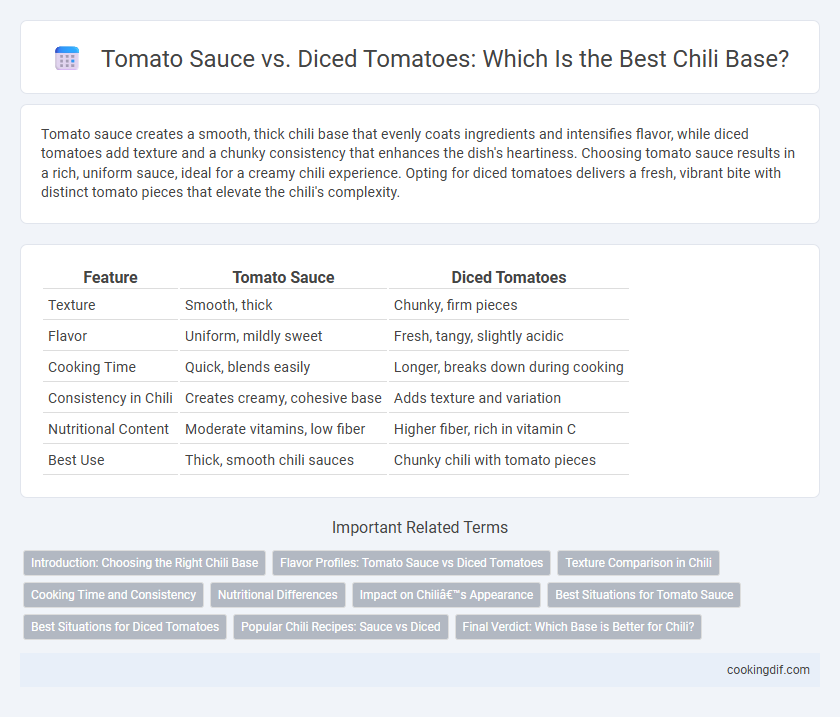Tomato sauce creates a smooth, thick chili base that evenly coats ingredients and intensifies flavor, while diced tomatoes add texture and a chunky consistency that enhances the dish's heartiness. Choosing tomato sauce results in a rich, uniform sauce, ideal for a creamy chili experience. Opting for diced tomatoes delivers a fresh, vibrant bite with distinct tomato pieces that elevate the chili's complexity.
Table of Comparison
| Feature | Tomato Sauce | Diced Tomatoes |
|---|---|---|
| Texture | Smooth, thick | Chunky, firm pieces |
| Flavor | Uniform, mildly sweet | Fresh, tangy, slightly acidic |
| Cooking Time | Quick, blends easily | Longer, breaks down during cooking |
| Consistency in Chili | Creates creamy, cohesive base | Adds texture and variation |
| Nutritional Content | Moderate vitamins, low fiber | Higher fiber, rich in vitamin C |
| Best Use | Thick, smooth chili sauces | Chunky chili with tomato pieces |
Introduction: Choosing the Right Chili Base
Tomato sauce provides a smooth, rich foundation for chili, enhancing the overall texture and blending seamlessly with spices. Diced tomatoes add a chunky, fresh burst of flavor that creates a heartier, more textured chili base. Depending on the desired consistency and flavor profile, selecting between tomato sauce and diced tomatoes can dramatically influence the final dish.
Flavor Profiles: Tomato Sauce vs Diced Tomatoes
Tomato sauce provides a smooth, rich base with a concentrated, slightly sweet flavor that blends seamlessly into chili, enhancing its overall depth. Diced tomatoes add texture and a fresh, tangy brightness, creating bursts of flavor that contrast with the meat and spices. Choosing between tomato sauce or diced tomatoes affects the chili's mouthfeel and taste intensity, with sauce offering uniformity and diced tomatoes contributing lively, chunky elements.
Texture Comparison in Chili
Tomato sauce provides a smooth and consistent texture that blends seamlessly into chili, creating a thick and uniform base. Diced tomatoes contribute a chunkier texture with visible tomato pieces, adding more bite and variation to each spoonful. Choosing between the two depends on whether a creamy or textured chili base is preferred for optimal mouthfeel.
Cooking Time and Consistency
Tomato sauce creates a smooth, consistent base that requires less cooking time, typically around 30 to 45 minutes, to fully integrate flavors in chili. Diced tomatoes offer a chunkier texture and need longer simmering, often 1 to 2 hours, to soften and blend with other ingredients, enhancing the chili's depth. Choosing tomato sauce results in a quicker, creamier chili, while diced tomatoes provide a heartier, more textured dish.
Nutritional Differences
Tomato sauce provides a smoother texture and is lower in fiber compared to diced tomatoes, making it easier to digest in chili recipes. Diced tomatoes retain more of their natural vitamins, including higher levels of vitamin C and antioxidants, contributing to enhanced nutritional value. Both options offer essential nutrients, but choosing diced tomatoes can increase dietary fiber and micronutrient intake in chili dishes.
Impact on Chili’s Appearance
Tomato sauce creates a smooth, uniform base that gives chili a rich, deep red color, enhancing its visual appeal and consistency. Diced tomatoes add texture and visible chunks, resulting in a more rustic, chunky appearance that highlights freshness and adds color variation through the natural tomato pieces. The choice between tomato sauce and diced tomatoes significantly affects chili's overall look, balancing between a polished finish and a hearty, rustic presentation.
Best Situations for Tomato Sauce
Tomato sauce is ideal for chili bases requiring a smooth, consistent texture and a rich, concentrated tomato flavor. It excels in slow-cooked recipes where the sauce can meld with spices and meats, creating a thick, cohesive chili. When quick cooking or a chunkier texture is not desired, tomato sauce provides a streamlined base that enhances the overall depth without overpowering other ingredients.
Best Situations for Diced Tomatoes
Diced tomatoes are ideal for chili recipes that benefit from a chunky texture and fresh tomato flavor, providing a more robust and hearty base compared to tomato sauce. They maintain their shape during cooking, making them perfect for slow-simmered chili where distinct tomato pieces enhance the dish's visual appeal and mouthfeel. Using diced tomatoes is especially advantageous in recipes aiming for a rustic or homemade style chili, where balance between liquid and solid components is desired.
Popular Chili Recipes: Sauce vs Diced
Popular chili recipes often debate the use of tomato sauce versus diced tomatoes as the base, each offering distinct textures and flavors. Tomato sauce provides a smooth, rich consistency that blends seamlessly with spices, enhancing the overall depth of the chili. Diced tomatoes contribute a chunkier texture and fresh, slightly acidic bite, adding complexity and a more rustic feel to traditional chili dishes.
Final Verdict: Which Base is Better for Chili?
Tomato sauce offers a smooth, rich base that blends seamlessly into chili, enhancing overall flavor without altering texture, while diced tomatoes provide a chunkier, fresher texture that adds complexity and body. For a classic chili with a thick, hearty consistency, tomato sauce is typically preferred due to its uniformity and depth in flavor. However, combining both ingredients often yields the best result, balancing smoothness with texture for a more dynamic chili base.
Tomato Sauce vs Diced Tomatoes for chili base Infographic

 cookingdif.com
cookingdif.com